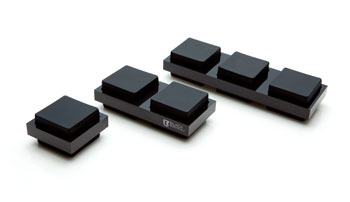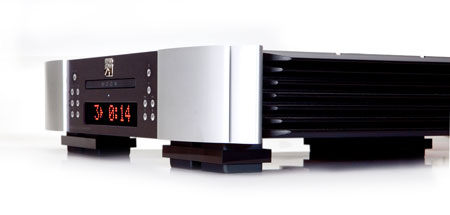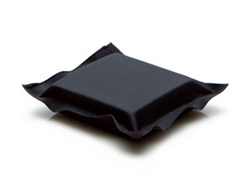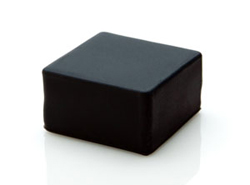 This
is a brief essay about my experience of resonance control and a
revisit and follow-up of the original ravioli-shaped pads review
I published about three years ago. I have — and still
use — quite a few Black Ravioli (BRs) in my systems, but
now have the company’s
latest additions to the line-up — three models of Big Foot
pads (single, double and triple), Sticky Pads 1 & 2 and a Big
Pad to accommodate equipment that needs more clearance/capacity.
A comprehensive guide in on the Black Ravioli website ( www.Blackravioli.com). This
is a brief essay about my experience of resonance control and a
revisit and follow-up of the original ravioli-shaped pads review
I published about three years ago. I have — and still
use — quite a few Black Ravioli (BRs) in my systems, but
now have the company’s
latest additions to the line-up — three models of Big Foot
pads (single, double and triple), Sticky Pads 1 & 2 and a Big
Pad to accommodate equipment that needs more clearance/capacity.
A comprehensive guide in on the Black Ravioli website ( www.Blackravioli.com).
Black Raviolis are the brainchild of Scotland-based Derek Ethell
who’s earlier American distributor introduced me to these
little pasta-shaped pillows that do not look like anything resembling
an audio accessory but, when applied, greatly impact the listening
experience.
The subject of resonance and the resulting vibrations is one of
my pet audio issues in which I have been interested ever since
the introduction of the Mod Squad Tip Toes that came onto the market
in the mid eighties. By 1986, I had experimented with various resonance-controlling
accessories and even made my own makeshift gadgets to improve the
sound of my turntable and CD player. I also experimented with speaker
stands and had a pair made for my Quad electrostats a couple of
years before the Arcici stands became available. At the time, I
chose wood for my two-foot high stands, tiptoed the Quads and — eventually — took
off the grilles and braced and dampened the internal structure
with strips of foam. Though not very professional, the results
were quite comparable with Quad 63 US monitors introduced in the
late 1980s, which had better bracing throughout their construction.
The bracing prevented the slight fluttering of the plastic cover
over the electrostatic panels, thus reducing vibrations and further
improving the speakers’ ability to focus imagery and — believe
it or not, their bass response energy. I had (still have) a two-position
stethoscope that I used for listening to resonating characteristics
of various materials used in the audio industry. Though not a scientific
approach, I learned that everything resonates, indeed everything
audio not only resonates but also picks up and amplifies all kinds
of resonance frequencies. In the late 1980s an abundance of accessories
focusing on resonance control hit the market — and I had
them all it seems. The materials used for these gadgets included
metal alloys, wood such as ebony, rubber, plastic, ceramics, air,
oil, water, cones, springs and spikes made of various metals, not
to speak of clamps, mats and Shun Mook Mpingo pucks — and
the list goes on. I soon found out that they all worked, although
they all changed the resonance frequencies or channeled energy
away from the main component, frequently with amazing, audible
effects. However, my research showed that none of the gadgets actually
eliminated resonances altogether. Enter, the first generation Black
Raviolis that, it appears, completely do away or absorb vibrational
stress — an almost intriguing achievement in light of their
design simplicity. It wasn’t until a few months ago that
I began to understand a little of the BR’s interaction with
all things audio. I took out aforementioned stethoscope, put it
on a Big Foot that I had placed on top of a pair of speakers and
listened to the naturally amplified sound. I was a bit disappointed
at first, because I clearly heard all sorts of resonances, all
across the audible frequency range. I then applied pressure to
the BRs and voila, dead silence. Magic? Not really, but then again,
my knowledge of physics is rather limited. All I know is that this
branch of science is concerned with the nature and properties of
matter and energy that includes mechanics, heat, light and other
radiation, sound, electricity, magnetism, and the structure of
atoms. All of this relates to and affects anything audio; and the
evidence is readily attainable by using the best instrument for
the job — the ears.
Of course, an evaluation of a tweak is a subjective nightmare;
not only because of the personal taste issue, but primary because
system components have dissimilar resonance characteristics — and
one tweak accessory isn’t going to be suited for all applications
and/or personal preferences.
Here is what I already know: the original BRs work fine under CD
players, turntables, amplifiers, preamplifiers, phono preamplifiers,
power supplies — well almost any electronic component one
may wish to put on a shelf, a rack or on the floor. It is because
any surface area will resonate when excited from airborne reflected
sound, generated by the loudspeakers. In addition, those feet or
cones on the bottom of components really cannot appropriately isolate
the chassis from the surface they are on, nor can they quash or
cancel the housing’s vibration. In fact, amps and preamps,
after having amplified a musical signal, their internal components — especially
the transformers — generate their own unwanted signal in
shape of hum and noise. A good component shelf or rack can do a
decent job; or a solid concrete foundation will help most equipment
placed upon it. However, I found that they all pale in comparison
to a simple inexpensive shelf (or the floor of the listening room)
with Raviolis placed strategically under the components, even when
they are already placed on resonance-reducing shelving.
The Sound
 Well, actually, the Black Raviolis do not produce sound of their
own, but do adjust or revise sound generated by the components
within an audio system. As I had done in the past, I began by
placing four of the original BRs (the little cushions) under
the supporting feet of one of my source components — a
Pioneer Elite player, used only as a transport. The result was — as
I expected — improved bass response, better, more defined
midrange and conspicuously obvious spatial elements on an improved
sound stage. When I replaced the original BRs with the new single
Big Foot pads, bypassing the transport’s feet, the sound
stage became even more defined, bass had additional weight and
resolution, and midrange was identical. High frequency information
seemed a bit subdued, although I liked how the BRs tamed the
edginess and stridency of some of my mass-produced CDs. Another
player I had in-house for an evaluation — the Atoll CD
400 — displayed similar improvements, although its chassis
and housing is in line with a Sherman tank’s, as it weighs
about 20 pounds. The player’s weight worked well with the
Big Foot pads and improved not only its bass and imaging elements,
but also expanded and defined midrange detail. Where there was
a bit of hardness or stridency, the BRs had tamed it without
adding pleasing or unpleasing colouration to the sound. Well, actually, the Black Raviolis do not produce sound of their
own, but do adjust or revise sound generated by the components
within an audio system. As I had done in the past, I began by
placing four of the original BRs (the little cushions) under
the supporting feet of one of my source components — a
Pioneer Elite player, used only as a transport. The result was — as
I expected — improved bass response, better, more defined
midrange and conspicuously obvious spatial elements on an improved
sound stage. When I replaced the original BRs with the new single
Big Foot pads, bypassing the transport’s feet, the sound
stage became even more defined, bass had additional weight and
resolution, and midrange was identical. High frequency information
seemed a bit subdued, although I liked how the BRs tamed the
edginess and stridency of some of my mass-produced CDs. Another
player I had in-house for an evaluation — the Atoll CD
400 — displayed similar improvements, although its chassis
and housing is in line with a Sherman tank’s, as it weighs
about 20 pounds. The player’s weight worked well with the
Big Foot pads and improved not only its bass and imaging elements,
but also expanded and defined midrange detail. Where there was
a bit of hardness or stridency, the BRs had tamed it without
adding pleasing or unpleasing colouration to the sound.
Three Big Foot triple pads worked best under the heavy Bryston
7B SST Squared amplifiers. The powerful Brystons’ sonic personality
didn’t change, but with the BRs bypassing their supporting
feet, deep bass became firmer with additional harmonic structure
above fundamentals. Midrange information seemed more liberated
as detail and spaces emerged on the sound stage, considerably adding
to the system’s tonal refinement.
Three double or four single BR pads placed under the integrated
Magnum amplifier provided similar results —an all-round sonic
improvement of I’d say 20%.
Each preamplifier I had in-house demonstrated a clearer, more transparent
performance when I placed four single pads with spacers under the
supporting feet. However, when I bypassed these feet with three
double Big Foot pads placed under the heaviest parts of the chassis,
I also noticed a marked improvement in the high frequency domain.
This arrangement resulted in a noticeably smoother signal flow,
which helped to refine the sound from around 650Hz (upper midrange)
all the way to 5kH (the beginning range of upper highs). Additionally,
sound stage dimensionality, space and focus on instruments and
voices also improved, though by a variable extent, depending on
the preamp’s chassis construction. In earlier tests, the
only preamplifier that didn’t benefit from single BR pads
was the Wyetech Labs Opel and, later, the Ruby models; these components
feature a ¼ inch steel case and one of the industry’s
best chassis. Nevertheless, with the new, more elaborate single
Big Foot pads, even the Ruby’s sound improved by adding subtle
refinements to its tone/voice. The most surprising sonic improvements — and
I admit to my incongruous approach — was when I squeezed
some of the original pasta between the preamps’ and CD players’ RCA
connectors and my auditioning speakers’ terminals. I used
six BRs in total and reached an advanced state of sonic stability,
that didn’t change the sound, but drew my attention to resolution,
focus and the sound-stage’s dimensions and spatial elements.
The sound had taken on an element of calmness and composure — a
feeling that all is right in musical terms.
Synopsis & Commentary
Most if not all vibration control accessories work by channeling
resonance away from one part of a component to another area that —hopefully — is
less problematic. It can be achieved with materials known for
their absorbing capacity or the ability to change the resonance
frequency; changing the energy into heat is another commonly
used method. The technique employed with the Black Raviolis is
a little bit of magic inasmuch as there are no documented material
specifications; and while I can’t properly explain how,
my stethoscope actually revealed that they do work well under
anything audio.
You should know that too many BRs might dampen the sound of certain
components, diminishing the energy in top frequencies. Therefore
it is important to follow a logical plan, whereby the overall system
sound must be taken into consideration. If your system sounds bright,
additional damping may well be what needs to be done. On the other
hand, if your system sounds dull and/or sluggish to begin with,
carefully placed single BRs pads would improve the sound quality,
but not actually change the fundamental makeup of the system sound.
Single pads will add space and focus on the sound stage, allow
cleaner, lower bass response and recreate better-defined dimensions,
especially in the front-to-back scope.
CD players coned with ceramic sounded best with the Raviolis placed
under the cones, while metal coned players sounded best when bypassing
the supports altogether and placing the chassis directly onto three
double BRs which are sandwiched between what appears to be a corian
plate.
For heavier equipment such as power amplifiers, I found that three
or four Big Foot pads did a great job by adding weight and resolution
to the bass as well as improving focus and spatiality to the image
on the sound stage.
I believe that the most effective all-round improvements can be
achieved by placing the BR’s under the preamplifier, elevating
it enough to clear its own supports. Though many high-end preamplifiers
have pretty good supporting feet, they will not sink vibrations
from the housing enclosure whereas three or four Big Foot and or
double BRs achieve just that. In my setups, I tested the BRs with
three preamplifiers including the recently reviewed tubed Allnic — and
every one of them clearly rendered sonic improvements, although
with varying degrees of accomplishment. What I am trying to say
is that the BRs must not be considered a band-aid solution/remedy
for a poorly designed component — in fact, I believe that
they will enhance quality as well as inferiority. However, with
premium electronics, especially in the very high-end, the use of
the BRs is an organic tweak that does not change the sound of a
great system; rather, it augments the components’ performance.
I believe that the use of Black Raviolis will enhance all (high-end)
systems with a more relaxed musical performance, adding additional
spaciousness, better-defined imagery and focus. This is pasta to
behold and a real effective way to improve everything audio — and
don’t forget BRs also work for video.
 |
 |
Black Ravioli Sticky 1 & 2 |
Black Ravioli Big Pad |
|
